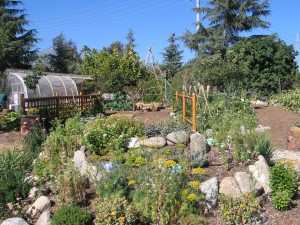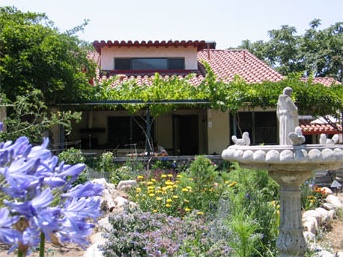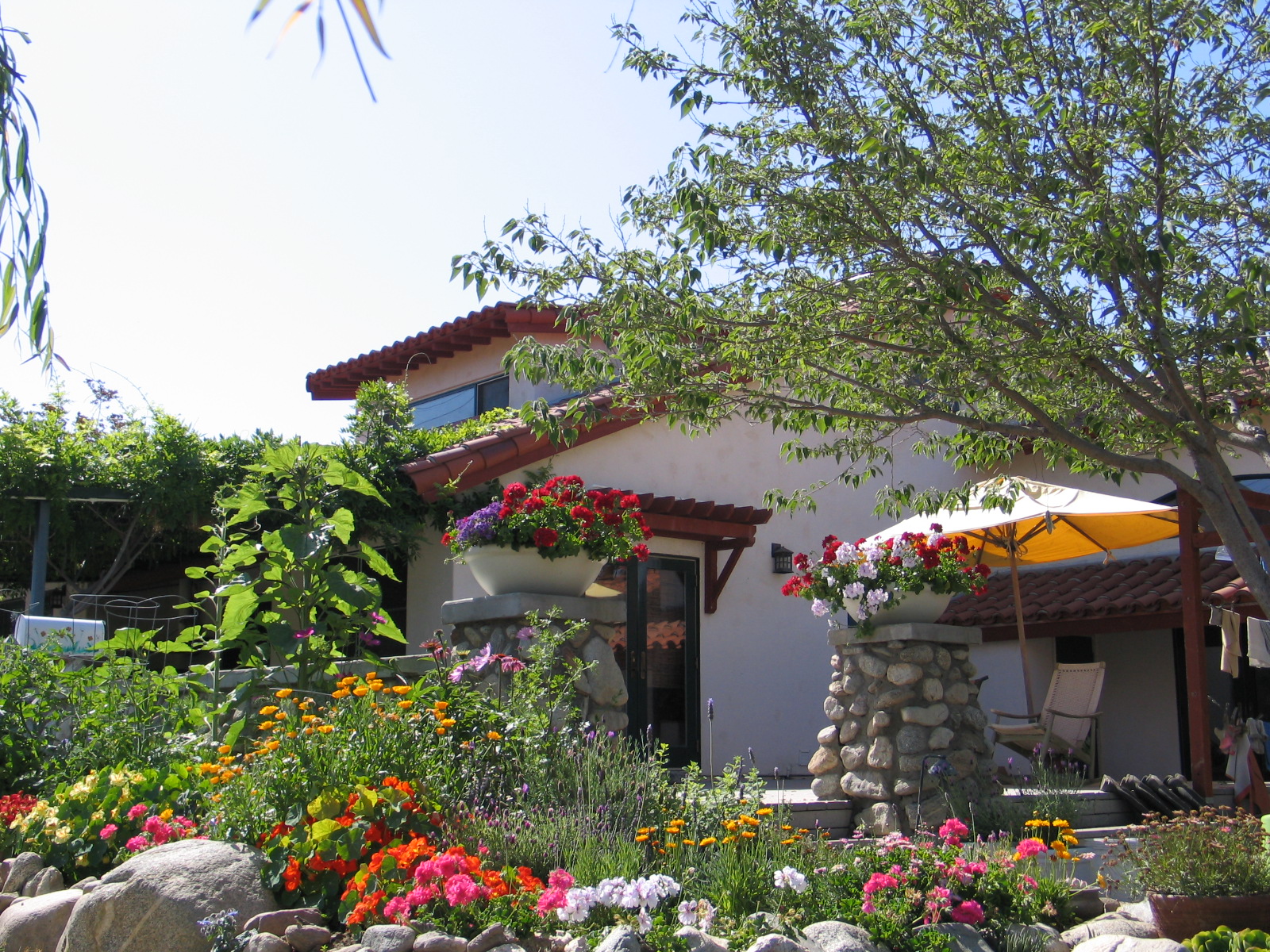Counting blessings…
 Among the countless things that I am grateful for this past year of 2012, the Living Water farm is on top of that list. The micro-size farm was created in the northeast corner lot of Myra House. Its core insight was inspired by an image that can be traced back to 2005. In that year, I travelled to Europe to visit monastic communities for my doctoral study. During my stay at Taize, an ecumenical community in France near the city of Cluny, I took a day off for a road trip seventy miles away to a city called Dijon. This is where the Abbey of Clairvaux, a Cistercian monastery founded by St. Bernard in the early twelfth century is located.
Among the countless things that I am grateful for this past year of 2012, the Living Water farm is on top of that list. The micro-size farm was created in the northeast corner lot of Myra House. Its core insight was inspired by an image that can be traced back to 2005. In that year, I travelled to Europe to visit monastic communities for my doctoral study. During my stay at Taize, an ecumenical community in France near the city of Cluny, I took a day off for a road trip seventy miles away to a city called Dijon. This is where the Abbey of Clairvaux, a Cistercian monastery founded by St. Bernard in the early twelfth century is located.
Walking by the town center, I was suddenly absorbed with the tranquil scene of the street side view. I saw a garden about half an acre in size filled with rows of vegetable beds. Green beans climbed over teepee poles and tomatoes crawled around upright bamboo stakes. Purplish scarlet poppy blossomed and the garlic chives’ white flowers danced. Immersed into the sublime natural beauty of a humble plot, I began murmuring, I want to live here, I wish I lived here with my family forever! I have kept this vivid image deep within my memory for the last seven years, never letting it fade away. This encounter and memory became a vision of the Living Waters Farm.
From the start of the garden’s planning, the key foundational features emerged along the process. First, each habitat’s cluster was identified: annual vegetables, perennial beds, herbal mound, wetland and diverse native hedges. For the ground preparation, piles of recycling material were reused: discarded carbon boxes, newspapers, green waste, PVC tubes and plastics. The farm began to take shape as we set up the low fences, gates, a trellis, bamboo teepees, an underground rain water channel, a greenhouse and sitting area. We implemented permaculture features: (1) to conserve water irrigating from the lily pond to the farm, (2) to enhance the soil quality by applying the crop rotation method (4 year cycle), homemade fertilizers, homegrown green manure, and earthworms, (3) to manage and deter unwanted pests and weeds by inter-planting and companion planting, and (4) to foster interactions within species and related species, dry land and wetland plants, and native shrubs and fruit trees.
The farm was ready for a visitors’ tour in March. We also held an open house in July, along with hosting the first “Sustainability” lecture series. The lectures were enriching by two keynote speakers’ presentations. From a social psychologist’s perspective: Vanessa Kettering challenged us to engage in solutions by emphasizing the individual’s critical choice for personal and global health. From an environmental scientist’s perspective, Dr. Guntram Ramutis defined and described sustainability as practiced at Living Water Farm as a way to reduce our needs in the face of increasing stress on our limited natural resources by today’s civilization. By the middle of the summer, the farm’s harvested volume surprised us all. We delivered more than two-dozen baskets of produce to local restaurants in addition to sharing with more than twenty farm members. Some of the noteworthy produce include: (1) the leafy green family of lettuce, kale, chard and collard greens, (2) the potato family of tomatoes, bell pepper, chili cayenne, and chili Serrano, (3) the marrow family of cucumber, squash, zucchini, eggplant and cantaloupe, (4) the onion family of leak, green onions and chives, and (5) the culinary herbs family of dill, thymes, oregano, parsley, cilantro and basils. In the middle of fall about three dozens pumpkins were harvested. Some were too large for me to wrap my arms around. Encouraged by the remarkable yields, we planted more edible perennials like mango, guava, sapote, cherimoya and 4 different kinds of berries.
A healing garden section was improved planting aloe vera, creeping rosemary, and a variety of lavender and sage. During the Thanksgiving holiday, the farm added winter vegetables such as Brussels sprouts, micro greens and potatoes. As Christmas arrived, we were able to taste the homemade culinary oils, salad dressings, and wild honey harvested by Lydia and James. As a future direction, we envision the farm becoming a sustainable model for healing and education. We have undertaken a creative project to discover new opportunities for collaboration. Currently the farm is open to visitors by appointment. We have posted more details and photos of the farm at: www.myrahouse.com/living-water-farm.
In about ten months’ time, a farm-centered life has taken us on a journey of intense learning and experiences. What we are convinced of is that more interaction is encouraged within a cluster of species and with new diverse species. The whole ecosystem of the farm becomes more life-vibrant. We were also delighted with how unexpected things happen and lead to surprising joy. For example, Morel mushrooms apparently only grow in particular forest woods and are highly priced in markets. Although we never planted them, they began growing in a corner of the berries section! There is so much to learn about each plant. The asparagus, for example, is known as a leading medicinal and culinary plant, provides a wide variety of nutrients, including vitamin C, beta-carotene, and the minerals zinc, manganese, and selenium. The plant can live eight to twelve years and can grow six to seven inches in one day.
Interestingly, we have also learned that farm activity cannot be romanticized. To block against the persistent intrusion of wild critters from the nearby wilderness trail, we built a fence with sturdy pine posts and strong wires that go two feet below into the ground. To battle against the gophers, we have tried most of the natural methods—using juicy gum, blocking the paths with thorny branches of rose and borgenvillia and filling the holes with chili pepper powder. No matter how thorough we try these methods, the gophers still make their ways in and mess up the plant roots and soil bed. But all in all, these are daily hindrances that are a part of this great gift of our encounter with nature.
Special thanks to the in-house residents who poured their positive energy into the farm and ignited our passion to grow more edible vegetables. The Sunday prayer and meditation group has also provided us with spiritual strength in our collective search for God’s presence in silence. We give great thanks to every farm member who has supported our endeavors wholeheartedly with their membership. I also appreciate all volunteers and interns who joined this laborious but promising journey.
Counting our blessings today and praying for your wholesome health and a bountiful harvest in the New Year…
Best Wishes,
Sung and Myra House Family
Comments are closed.

 Welcome to the Myra House Holistic Living Center -
Welcome to the Myra House Holistic Living Center -

Glad to have been of service in the creation of this inspired landscape 🙂
Maybe someday I can plan a visit. If I ever make it across the continent.
Loved the photos.
Blessed be, Jo